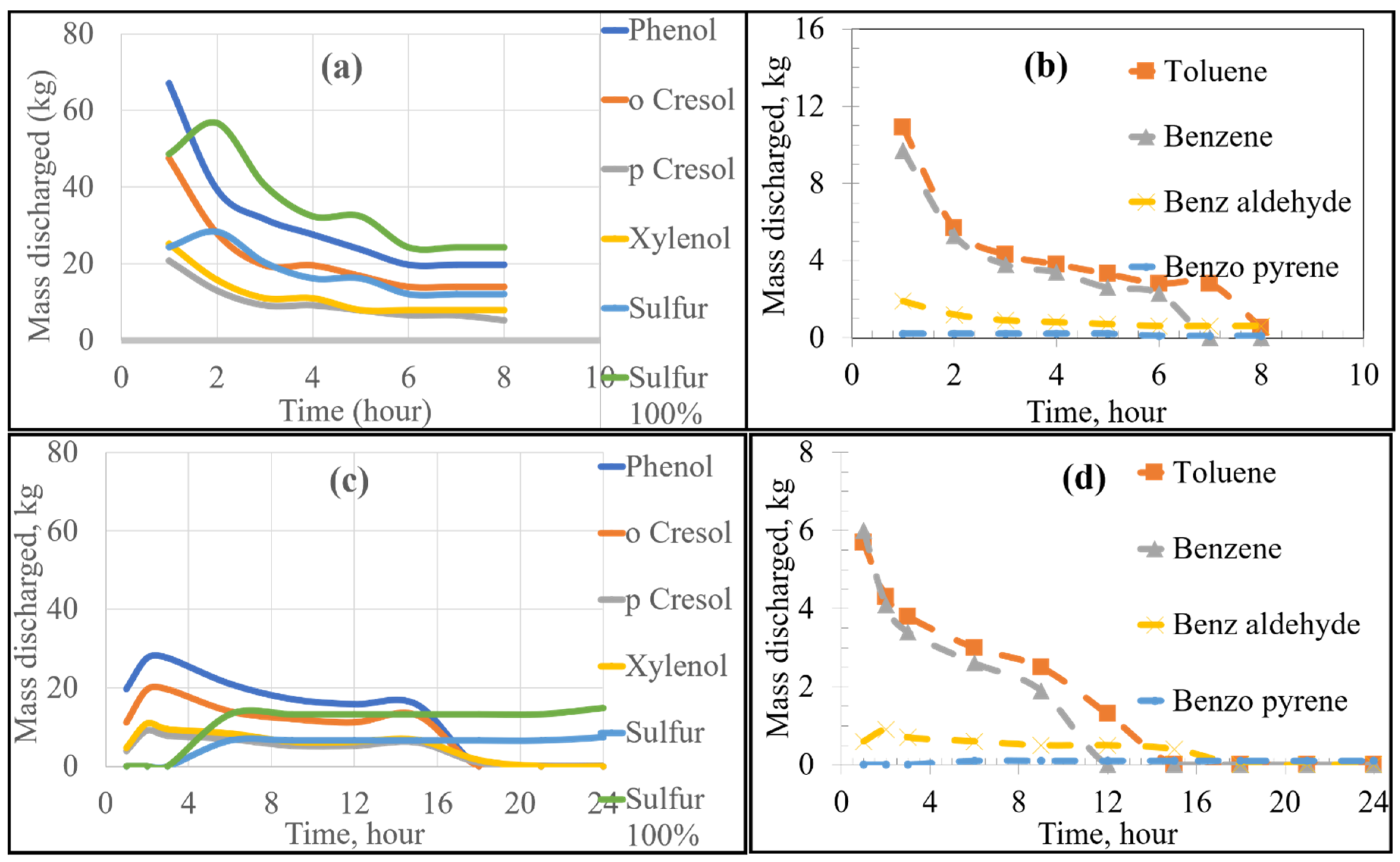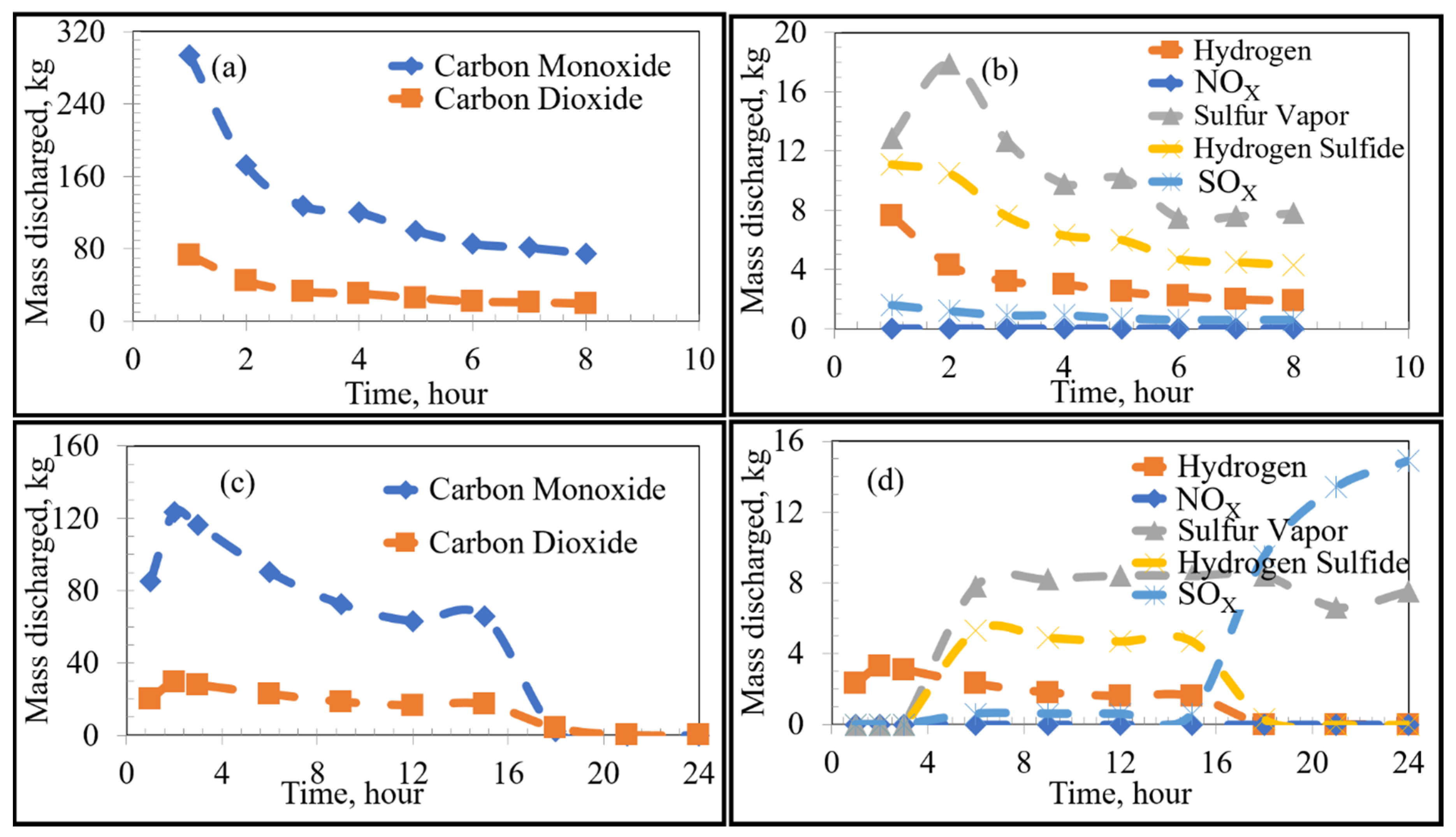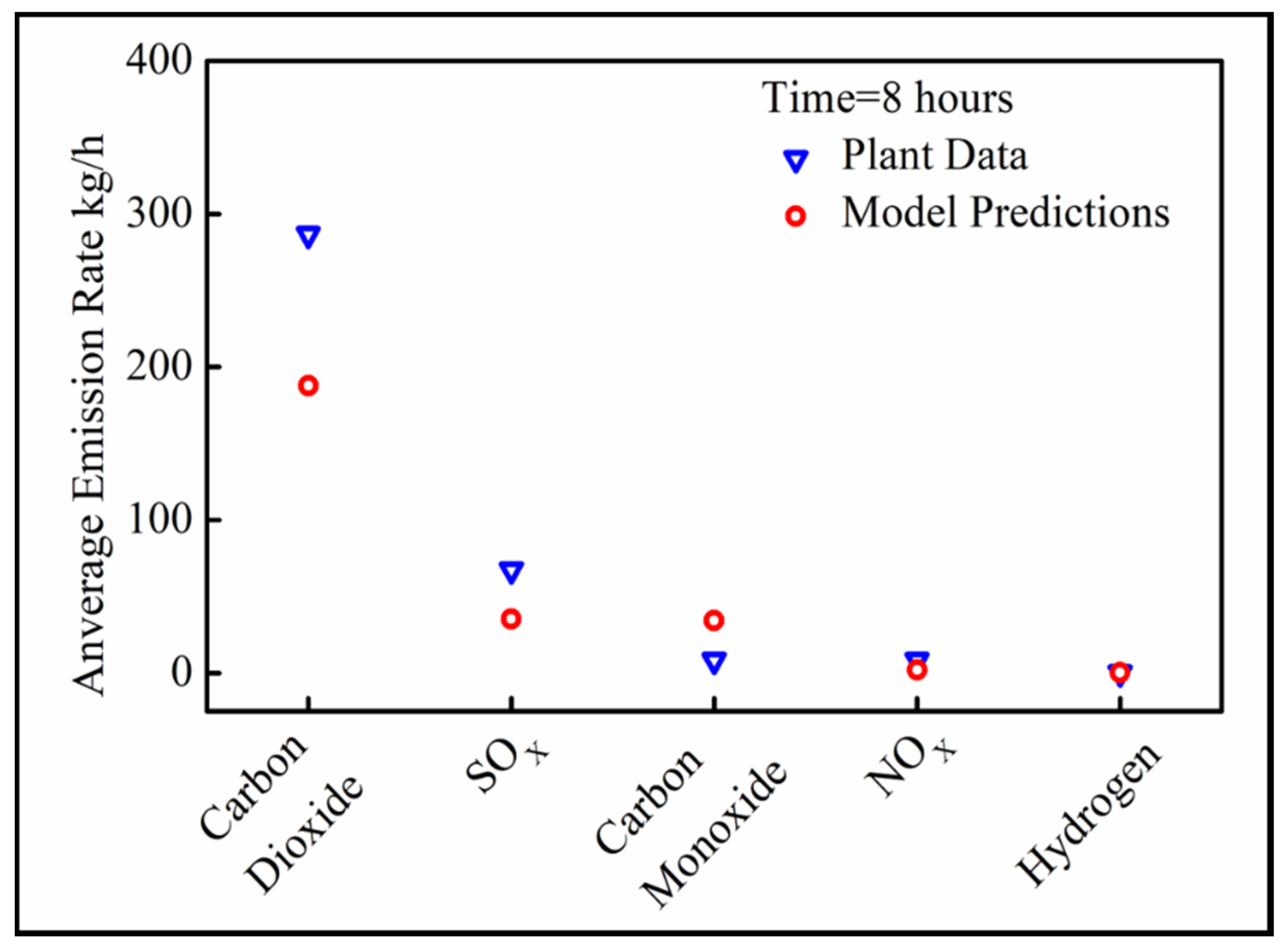Numerical Modeling of Volatile Organic Compounds (VOC) Emissions during Preheating of Magnesia-Carbon Bricks in a Basic Oxygen Furnace
Abstract
:1. Introduction
2. Modeling Approach
2.1. Heat Transfer Modeling
2.2. Emission Rate Modeling
2.3. PreHeating Process Boundary Conditions and Material Parameters Utilized
3. Results and Discussion
3.1. Temperature Profile of KOBM Vessel Wall as a Function of Preheating Procedure
3.2. Emission Rates as a Function of Preheating Completion
3.3. Model Verification
4. Conclusions
Author Contributions
Funding
Acknowledgments
Conflicts of Interest
Nomenclature
| KOBM | Klockner Oxygen Blown Maxhutte |
| BOF | Basic Oxygen Furnace |
| VOC | Volatile Organic Compounds |
| POC | Products of Combustion |
| Fo | Fourier Number |
| dt | timestep, s |
| dx | mesh cell size, m |
| a | mesh cross-section, m2 |
| L | system length, m |
| t | system time, s |
| p | density, kg/m3 |
| Cp | isobaric specific heat capacity, J/kg·K |
| K | thermal conductivity, W/m·K |
| σ | Stefan-Boltzmann constant, W/m2·K4 |
| ε | emissivity |
| α | thermal diffusivity, m/s2 |
| Tflame, | flame temperature, K |
| Tconv | gas convection temperature, K |
| h | convective heat transfer coefficient, W/m2·K |
| q | general heat flux, W/m2 |
| qradaition | radiative heat flux, W/m2 |
| qconvection | convective heat flux, W/m2 |
| qconduction | Conductive heat flux, W/m2 |
| Tt,x | cell temperature at time t and position x, K |
References
- Buchebner, G.; Piker, S. New high preformance refractories for BOF-vessels. Veitsch-Radex Rundschau. 1996, 2, 3–14. [Google Scholar]
- Trinowski, D.M. Report-Environment improvement to UCB binders & the CORDIS processes. In Proceedings of the USEPA meeting on innovative binders for the iron and steel foundaries, Research Triangle Park, NC, USA, 26 October 2005. [Google Scholar]
- Department of the Environment, Canadian Envirmental Protection Act. 1999. Available online: http://www.gazette.gc.ca/rp-pr/p1/2017/2017-05-06/html/sup2-eng.html (accessed on 6 April 2020).
- Kesselmeier, J.; Staudt, M. Biogenic volatile organic compounds (VOC): An overview on emission, physiology and ecology. Environ. Pollut. 2000, 33, 23–88. [Google Scholar]
- Simpson, I.J.; Akagi, S.K.; Barletta, B.; Blake, N.J.; Choi, Y.; Diskin, G.S.; Fried, A.; Fuelberg, H.E.; Meinardi, S.; Rowland, F.S.; et al. Boreal forest fire emissions in fresh Canadian smoke plumes: C1-C10 volatile organic compounds (VOCs), CO2, CO, NO2, NO, HCN and CH3CN. Atmos. Chem. Phys. 2011, 11, 6445–6463. [Google Scholar] [CrossRef] [Green Version]
- Zheng, J.; Shao, M.; Che, W.; Zhang, L.; Zhong, L.; Zhang, Y.; Streets, D. Speciated VOC emission inventory and spatial patterns of ozone formation potential in the Pearl River Delta, China. Environ. Sci. Technol. 2009, 43, 8580–8586. [Google Scholar] [CrossRef] [PubMed]
- Arden Pope, C.; Burnett, R.T.; Turner, M.C.; Cohen, A.; Krewski, D.; Jerrett, M.; Gapstur, S.M.; Thun, M.J. Lung cancer and cardiovascular disease mortality associated with ambient air pollution and cigarette smoke: Shape of the exposure-response relationships. Environ. Health Perspect. 2011, 119, 1616–1621. [Google Scholar] [CrossRef] [PubMed] [Green Version]
- Chameides, W.L.; Kasibhatla, P.S.; Yienger, J.; Levy, H., II. Growth of continental-scale metro-agro-plexes, regional ozone pollution, and world food production. Science 1994, 264, 74–77. [Google Scholar] [CrossRef] [PubMed] [Green Version]
- Buchebner, G.; Sampayo, L.; Samm, V.; Blondot, P.; Peruzzi, S.; Boulanger, P. Ankersyn—A new generation of periclase-carbon refractories using a carbonaceous binder. Refract. Indistrial Ceram. 2005, 46, 291–294. [Google Scholar] [CrossRef]
- Chattopadhyay, K.; Liu, X.; Chatterjee, S. Integrated modelling of CFD and Thermodynamics for prediction of organic emissions during pre-heating of magnesia-carbon bricks. In Proceedings of the Name of the METEC & 2nd ESTAD Conference, Düsseldorf, Germany, 15–19 June 2015. [Google Scholar]
- Kramer, C.; Mühlbauer, A.; Von Starck, A. Handbook of Thermoprocessing Technologies: Fundamentals, Processes, Components, Safety; Vulkan-Verlag: Essen, Germany, 2005. [Google Scholar]
- Moch, W.; Gregor, M.A.; Adler, W.; Bender, W.; Burkat, C.; de Fries, U.; Mess, H.; Wiedemeier, F.J.; De Angelis, V.; De Paolis, G.; et al. EUR 23175-Investigations and Measures to Reduce Emissions and Energy Consumption during the Preheating of Steel Ladles; European Commission Report, Contract No RFSR-CT-2003-00008; RFCS Publications: Luxembourg, 2008; pp. 1–113. [Google Scholar]
- Volkova, O.; Janke, D. Modelling of Temperature Distribution in Refractory Ladle Lining for Steelmaking. ISIJ Int. 2003, 43, 1185–1190. [Google Scholar] [CrossRef]
- Bender, W.; Sucker, D.; Niggeschmidt, W. Neuartiges thermisches Drehgenerator-Brenner-System zur besseren Energieausnutzung in Hochtemperatur-Prozeßfeuerungen. VDI Berichte. 2001, 1629, 193–198. [Google Scholar]
- Gunther, R. Verbrennung Und Feuerungen; Springer: Berlin, Germany, 1974. [Google Scholar]
- Baukal, C.E., Jr. Industrial Burners Handbook—Industrial Combustion Series; CRC Press Inc.: Boka Raton, FL, USA, 2003. [Google Scholar]
- Kelly, J.; Dentella, F.; Recanati, A.; Visus, J.; Mielo, E. Oxygen-Enhanced ladle preheating systems: Improved tap-to-tap cycle time and operating cost reductions. Iron Steel Technol. 2011, 8, 307–311. [Google Scholar]
- Drózd-Rys, M. Impact of Steel Ladle Preheating on the Decarburization of a MgO-C Refractory Lining. Ph.D. Thesis, Montanuniversität Leoben, Leoben, Austria, March 2015. [Google Scholar]
- Manthur, P.; Riley, M.F.; Nandi, A.; Nath, R.; Ghosh, A. Improving Energy Efficiency and Reducing Emissions in the Steel Industry with Praxair’s Oxy-Fuel Technologies. Steel Tech, January 2014; No. 1, India. [Google Scholar]
- Cates, L.; Nakao, T.; Shimamoto, T. Performance and Results of Praxair’s DOC Technology for Ladle Preheating at Steel Mill in Japan. In Proceedings of the Name of the AIST Conference, Indianpolis, IN, USA, 2–5 May 2011. [Google Scholar]
- Scheele, J.; Ekman, T. Effieient Heating a With Low Calorific Gases, No. 3; Nordic Steel and Mining Review: Bergsmannen, Sweden, 2008; pp. 24–26. [Google Scholar]
- Industrial Gases Denmark. Available online: https://www.linde-gas.dk/da/processes_ren/melting_heating/ladle_heating/index.html (accessed on 28 April 2020).
- Bobek, J.; Scifres, M.; Hemandez, M.; Kelly, J. Stove Oxygen Enrichment at ArcelorMittal’s 7. Blast Furnace. In Proceedings of the Association for Iron & Steel Technology, Pittsburgh, PA, USA, 5–8 May 2008. [Google Scholar]
- Ladle Heating. Available online: https://promeos.com/solutions/ladle-heating/?lang=en (accessed on 7 May 2020).
- Pupeikis, D.; Stankevičius, V.; Burlingis, A. The effect of the fourier number on calculation of an unsteady heat transfer of building walls. J. Civ. Eng. Manag. 2010, 16, 298–305. [Google Scholar] [CrossRef]
- Bale, C.W.; Bélisle, E.; Chartrand, P.; Decterov, S.A.; Eriksson, G.; Gheribi, A.E.; Hack, K.; Jung, I.H.; Kang, Y.B.; Melançon, J.; et al. FactSage thermochemical software and databases, 2010–2016. Calphad 2016, 54, 35–53. [Google Scholar] [CrossRef] [Green Version]
- Kayadelen, H.K. Effect of natural gas components on its flame temperature, equilibrium combustion products and thermodynamic properties. J. Nat. Gas Sci. Eng. 2017, 45, 456–473. [Google Scholar] [CrossRef]








| Component | Wt. % | Component |
| Magnesium Oxide (MgO) | 83.5 | Magnesium Oxide (MgO) |
| Graphite | 16.4 | Graphite |
| Sulfur | 0.1 | Sulfur |
| Emittable Compound | kg of VOC/ton of brick used | Boiling Point (K) |
| Phenol | 1.000 | 454.7 (181.7 °C) |
| o-Cresol | 0.710 | 464.0 (191 °C) |
| p-Cresol | 0.330 | 474.8 (201.8 °C) |
| Xylenol | 0.400 | 476.0 (203 °C) |
| Toluene | 0.120 | 383.6 (110.6 °C) |
| Benzene | 0.095 | 353.1 (80.1 °C) |
| Benzaldehyde | 0.028 | 451.1 (178.1 °C) |
| Benzopyrene | 0.010 | 768.0 (495 °C) |
| Sulfur | 0.100 | 717.7 (444.7 °C) |
| Parameters | Symbol | Bricks | Shell | Units |
| Thermal Conductivity | k | 10 | 60 | W/m2K |
| Density | ρ | 2500 | 7800 | kg/m3 |
| Heat Capacity | Cp | 960 | 502 | J/kg·K |
| Emissivity | ε | 0.1 | 0.8 | - |
| Parameters | Symbol | Existing Procedure | Proposed Procedure | Units |
| Initial/External Ambient Temperature | T0,x | 298 | K | |
| Flame Temperature | Tflame | 1500 | 2250 | K |
| Convective Temperature | Tconv | 1500 | 1700 | K |
| Internal Heat Transfer Coefficient | hout | 30 | W/m2K | |
| External Heat Transfer Coefficient | hin | 10 | W/m2K | |
© 2020 by the authors. Licensee MDPI, Basel, Switzerland. This article is an open access article distributed under the terms and conditions of the Creative Commons Attribution (CC BY) license (http://creativecommons.org/licenses/by/4.0/).
Share and Cite
Dinda, S.K.; Chattopadhyay, K. Numerical Modeling of Volatile Organic Compounds (VOC) Emissions during Preheating of Magnesia-Carbon Bricks in a Basic Oxygen Furnace. Metals 2020, 10, 1277. https://doi.org/10.3390/met10101277
Dinda SK, Chattopadhyay K. Numerical Modeling of Volatile Organic Compounds (VOC) Emissions during Preheating of Magnesia-Carbon Bricks in a Basic Oxygen Furnace. Metals. 2020; 10(10):1277. https://doi.org/10.3390/met10101277
Chicago/Turabian StyleDinda, Soumitra Kumar, and Kinnor Chattopadhyay. 2020. "Numerical Modeling of Volatile Organic Compounds (VOC) Emissions during Preheating of Magnesia-Carbon Bricks in a Basic Oxygen Furnace" Metals 10, no. 10: 1277. https://doi.org/10.3390/met10101277
APA StyleDinda, S. K., & Chattopadhyay, K. (2020). Numerical Modeling of Volatile Organic Compounds (VOC) Emissions during Preheating of Magnesia-Carbon Bricks in a Basic Oxygen Furnace. Metals, 10(10), 1277. https://doi.org/10.3390/met10101277





